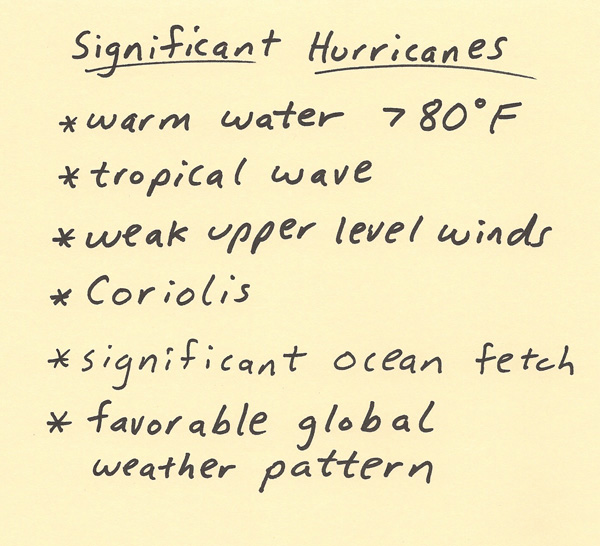
Like tornadoes, hurricanes can have very strong winds that are capable of significant destruction and they capture the imagination of people interested in nature’s fury and severe meteorological phenomena. Unlike tornadoes, hurricanes can do damage to a very large area. A land-falling significant hurricane is a sensational event with wall-to-wall media coverage and atmospheric observation. A significant hurricane is defined as a hurricane that is Category 3 or above and thus has maximum sustained winds of 111 miles per hour or greater. The maximum sustained wind is a theoretical value based on raw data derived from hurricane hunter measurements, buoy measurements, surface pressure, and other meteorological measurements of the storm. Since it is a theoretical maximum based on raw data, observed surface winds will almost always be less than the theoretical value unless the hurricane is strengthening rapidly and the latest update is yet to come out. There are several ingredients that are typically in place when a significant hurricane develops. One essential ingredient is warm water. A water temperature of 80 F or higher is the general threshold needed for a hurricane to develop. It is the case that the higher the temperature then the better. Explosive development can occur when a tropical system moves over 90 F water. Typically water temperature will be in the 80’s during a hurricane event. If the water near the coast is less than 80 F, then the hurricane can weaken just before landfall due to the loss of the access to the warm water. The warm water is the latent heat that drives the convection in the eye wall of the storm. Enormous amounts of energy are produced from the latent heat of condensation when water vapor is condensed out of the air. Another essential ingredient is a tropical wave. This is the nucleus for the storm to develop upon. Tropical waves can be a complex of thunderstorms that forms over the ocean or forms over land then moves over the ocean. If these waves have trouble developing or there is a lack of development in the first place then there can be several days to weeks that go by without a hurricane developing. Another ingredient that is linked with the previous ingredient is to have weak upper level winds. If the upper level winds are strong, then tropical waves will remain weak or will not develop in the first place. A tropical wave needs weak upper level wind so that the energy can be focused over an isolated region. The warm core structure developed by large amounts of latent heat release needs to develop in order for a hurricane to form and weak upper level winds are needed for this structure to properly develop. Winds aloft that are too strong will shear the tropical wave and will not allow energy to focus over the thunderstorm complex. Hurricanes develop in the equatorial latitudes but not at the equator. A hurricane can not cross from one side of the equator to the other. This is because of Coriolis. In order for a complex of storms to be influenced by a rotation, there must be Coriolis. The Coriolis increases with increasing latitude with Coriolis being zero at the equator and a maximum at the poles. It also takes time for a complex of thunderstorms to develop into a hurricane. The complex of storms needs to be over warm open ocean for a significant amount of time. Thus, hurricanes need space over an open body of ocean in order to develop. Once a tropical system moves over land it will weaken rapidly. The last ingredient to consider is the global weather pattern. Often forecasts will be made before and at the beginning of the hurricane season for the expected amount of tropical storms, hurricanes and significant hurricanes in the Atlantic Ocean and Pacific Ocean. The global weather pattern is an important contributor to upper level wind shear, ocean temperature, and the development of tropical waves. Thus, it is a combination of several of the previous factors mentioned that the global weather pattern can influence. The global weather pattern can lead to below normal, near normal or above normal tropical activity. This pattern can change in the middle of the hurricane season thus it is constantly monitored.  |